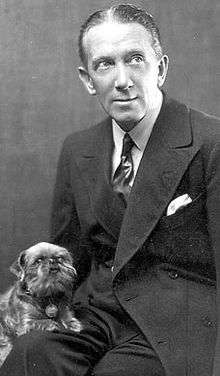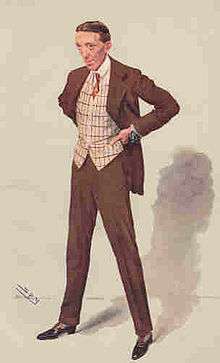Gerald du Maurier
Sir Gerald Hubert Edward Busson du Maurier (26 March 1873 – 11 April 1934) was an English actor and manager. He was the son of the author George du Maurier and brother of Sylvia Llewelyn Davies. During 1902, he married the actress Muriel Beaumont with whom he had three daughters: writers Angela du Maurier (1904–2002) and Daphne du Maurier (1907–1989), and painter Jeanne du Maurier (1911–1997).[1][2] His popularity was due to his subtle and naturalistic acting: a "delicately realistic style of acting that sought to suggest rather than to state the deeper emotions".[3] His Times obituary said of his career: "His parentage assured him of engagements in the best of company to begin with; but it was his own talent that took advantage of them."
Gerald du Maurier | |
|---|---|
 | |
| Born | Gerald Hubert Edward Busson du Maurier 26 March 1873 |
| Died | 11 April 1934 (aged 61) |
| Occupation | Actor |
| Years active | pre-1900–1934 |
| Parent(s) | George du Maurier and Emma Wightwick |
Early life

Du Maurier was born in Hampstead, London, and attended Heath Mount School[4] and Harrow School. He initially pursued a career in business, but it did not suit him, and he began working as an actor. He obtained his first engagement, a small part in Sydney Grundy's An Old Jew, by means of his father's friend John Hare, manager of the Garrick Theatre.
J.M. Barrie
After playing a number of small roles pre-1900, including a part in his father's popular drama Trilby with Herbert Beerbohm Tree during 1895, his popularity became assured as a result of his acclaimed performance in major roles in the premieres of two J.M. Barrie plays: as Ernest in The Admirable Crichton during 1902, and the dual role of George Darling and Captain Hook (instead of Seymour Hicks, who had refused the part) in Peter Pan, or The Boy Who Wouldn't Grow Up, at the Duke of York's Theatre, London, on 27 December 1904. He also played in other Barrie plays, including Dear Brutus.
His nephews, his sister Sylvia Llewelyn Davies's sons, were the inspiration for Peter Pan and other boy characters of Barrie's fiction. The character of Wendy Darling in Peter Pan shares one of her middle names with du Maurier's daughter Angela, who in later years portrayed Wendy onstage herself.
Theatre
With Frank Curzon, he co-managed Wyndham's Theatre from 1910 to 1925, and then worked for the St James's Theatre. Knighted during 1922 at the maximum of his popularity, he continued to perform throughout his life. During later years he acted cinema roles such as Lord Camber's Ladies (1932), a German doctor in I Was a Spy (1933), the emperor's valet in Catherine the Great (1934) and, soon before his final illness, Wessensee in the Michael Balcon version of Jew Süss (1934).
Du Maurier cigarettes
Du Maurier was a regular cigarette smoker, and the du Maurier brand was named after him as a paid endorsement deal (he did not smoke them himself), to which he agreed to help pay taxes owed.[5]
Charity work
He served as President of the Actors' Orphanage Fund (now the Actors' Charitable Trust) from 1914 to his death, when he was succeeded by Noël Coward.
Freemason
He joined the Freemasons' Green Room Lodge No. 2957 on 4 November 1904, an actors' lodge which included Leedham Bantock, Fred Terry and George Grossmith Jr. among its members.[6]
Death
He died on 11 April 1934 of colon cancer, at Cannon Hall, Cannon Place, Hampstead, his home since 1916. A blue plaque has been placed at the house in his memory.[7] His daughter Daphne refused to attend his funeral[1] but wrote a biography of him – Gerald: A Portrait – which was published soon after his death.
Filmography
| Year | Title | Role | Notes |
|---|---|---|---|
| 1917 | Masks and Faces | Hunsdon | Film debut |
| Everybody's Business | Tom Briton | Short | |
| Justice | Falder | ||
| 1920 | Unmarried | Rev. Roland Allington | |
| 1930 | Escape | Captain Matt Denant | |
| 1932 | Lord Camber's Ladies | Dr. Napier | |
| 1933 | I Was a Spy | Doctor | |
| 1934 | The Scotland Yard Mystery | Commissioner Stanton | |
| The Rise of Catherine the Great | Lecocq | ||
| Jew Süss | Weissensee | Final film | |
Selected stage credits
- The Dancers by Viola Tree (1923)
- Behold, We Live by John Van Druten (1932)
References and sources
- References
- Conradi, Peter J (1 March 2013). "Women in love: The fantastical world of the du Mauriers". ft.com. Retrieved 3 March 2013.
- Dunn, Jane Daphne du Maurier and Her Sisters, Harper Press (2013)
- Britannica 2005
- Gerald: A Portrait, Daphne du Maurier, Doubleday, Doran & Company, 1935 Google Books
- "Du Maurier Cigarettes". www.dumaurier.org. Retrieved 5 February 2017.
- "Join Ancestry". www.ancestry.co.uk.
- "Gerald du Maurier - Blue Plaque". openplaques.org. Retrieved 22 November 2013.
- Sources
- Sir Gerald du Maurier, Actor, Manager and Producer, Obituary, The Times, 12 April 1934
- James Harding, "Du Maurier, Sir Gerald Hubert Edward Busson (1873–1934)", Oxford Dictionary of National Biography, Oxford University Press, 2004 accessed 10 Sept 2007
External links
| Wikimedia Commons has media related to Gerald du Maurier. |
- Gerald du Maurier at the Internet Broadway Database

- The Admirable Crichton - 1902 production, The Play Pictorial No. XI (1903).
- Gerald du Maurier at University of Exeter Special Collections